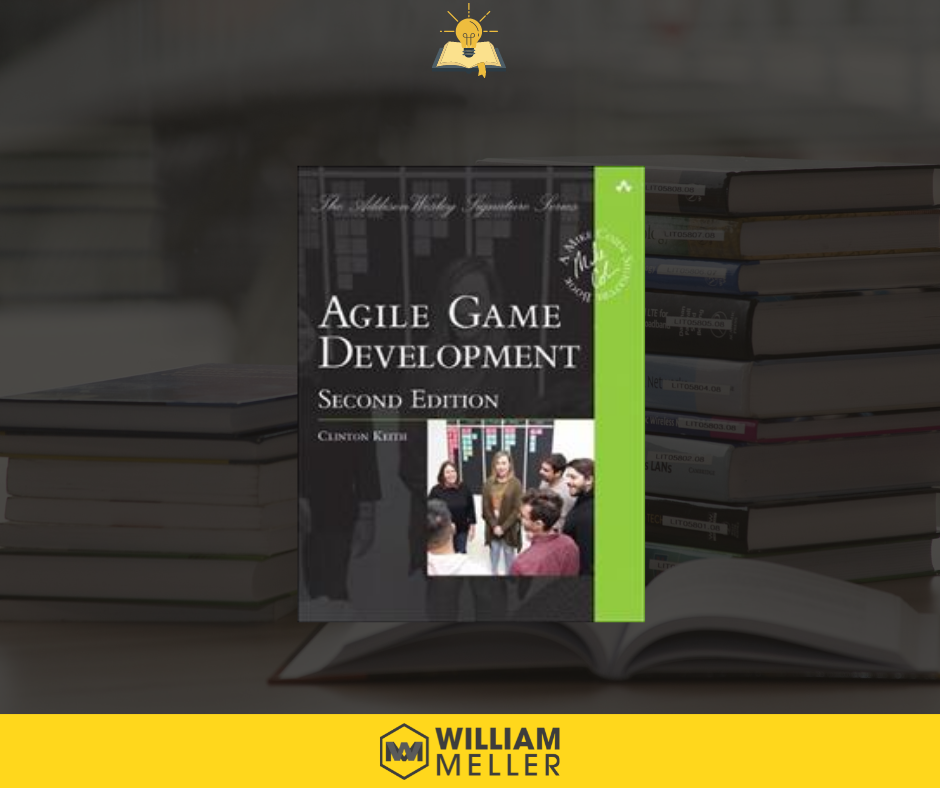
In this book, you will learn how to form successful agile teams and promote effective collaboration within and beyond those teams, throughout the entire process.
Summary
Title: Agile Game Development with Scrum
Author: Clinton Keith
Themes: Agile, Career, Cases, Technology, Management
Year: 2010
Publisher: Addison-Wesley
ISBN: 0321670310, 9780321670311
Pages: 227
Game development is in crisis—facing bloated budgets, impossible schedules, unmanageable complexity, and death march overtime.
It’s no wonder so many development studios are struggling to survive. Fortunately, there is a solution. Scrum and Agile methods are already revolutionizing development outside the game industry.
Now, long-time game developer Clinton Keith shows exactly how to successfully apply these methods to the unique challenges of game development.
Clinton Keith has spent more than fifteen years developing games, seven of them with Scrum and agile methods. Drawing on this unparalleled expertise, he shows how teams can use Scrum to deliver games more efficiently, rapidly, and cost-effectively; craft games that offer more entertainment value; and make life more fulfilling for development teams at the same time.
This book helps you in understanding Scrum’s goals, roles, and practices in the context of game development, helping to communicate and plan your game’s vision, features, and progress.

In Agile Game Development with Scrum, Clint shares his experience and insights, telling us everything we need to know to successfully use Scrum in the challenging field of game development.
In doing so, he provides an introduction to agile and Scrum and tells us how they can help manage the increasing complexity facing most game development efforts.
Along the way, Clint offers invaluable guidance on getting all the specialists who are necessary on a game project to work together in an agile manner. He even delves into how to use Scrum when working with a publisher.
My Book Highlights:
"... Because Scrum is iterative and incremental and forces a team to put the game into a playable state at least every two to four weeks, the team members can see new features and scenarios develop right before their eyes..."
"... A ScrumMaster’s role on the team is compared to a sheepdog. They guide the team toward the goal by enforcing boundaries, chasing off predators, and giving the occasional bark..."
"... The goal isn’t to find ways to utilize everyone’s time fully. To respond to work that couldn’t be planned for, there has to be a certain amount of “slack” available. Ultimately this slack, which allows everyone to respond quickly to problems, is more effective than attempting to plan it all away..."
"... Helping developers find flow in their work involves finding the appropriate level of challenge while they increase their skills..."
In providing all of this guidance, Clint doesn’t shy away from the challenges. Instead, he generously shares his advice so that we can perhaps avoid some of them.
The book explores agile basics and provides readers with the tools and strategies needed to successfully manage game development.
Some key insights and learnings from the book include:
- Understand agile principles and Scrum methodology.
- Utilize Scrum tools and techniques to create successful games.
- Foster collaboration and trust between teams.
- Increase productivity and reduce costs.
- Manage risk and make informed decisions.
- Optimize game design and development processes.
It condenses much information from a number of fields of agile product development and applies it to the game industry’s unique ecosystem. It’s based on the experiences of dozens of studios that have shipped games using agile over the past six years
Chapters of the Book:
I. The Problem and the Solution
1 The Crisis Facing Game Development
2 Agile Development
II. Scrum and Agile Planning
3 Scrum
4 Sprint
5 User Stories
6 Agile Planning
III. Agile Game Development
7 Video Game Project Planning
8 Teams
9 Faster Iterations
IV. Agile Disciplines
10 Agile Technology
11 Agile Art and Studio
12 Agile Design
13 Agile QA and production
V. Getting Started
14 The Myths and Challenges of Scrum
15 Working with a Publisher
16 Launching Scrum
In conclusion, Agile Game Development with Scrum is a must-read for teams who want to develop successful video games.
Featuring practical advice and real-world examples, the book provides readers with the tools and strategies needed to implement agile principles to develop games efficiently and effectively.
By using Scrum tools and techniques, teams can foster collaboration, reduce costs, and manage risk to ensure successful game development.
Clinton Keith is an independent agile coach and instructor for the games industry with more than fifteen years of video game development experience.
I am incredibly grateful that you have taken the time to read this post.
Your support and engagement mean the world to me, and I truly appreciate your interest in the topics I write about.
I hope that you have found this post informative, educational and engaging.
If you are interested in reading more of my work, please visit other articles here on the website.
I promise to continue providing valuable and high-quality content for your enjoyment and education.
Thank you again for reading and I hope to see you soon!
Here are some related articles you may enjoy:
There are even more good things I've prepared for you!
Subscribe below or click here to receive new posts in your Email!
Do you want to read some book notes and recommendations? Discover more here!
Do you want to have amazing weekly content curation? Discover more here!
Ready to make a positive impact?
Support my work by sharing my content with your network.
Your simple act of kindness can reach new heights and help spread valuable information.
Want to show your support in a tangible way? A virtual coffee is a small but mighty way to show your appreciation and give me the extra energy to keep crafting valuable content!



